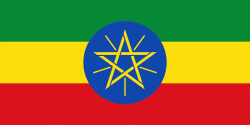Shire Airport (Shire Inda Selassie Airport)
Shire Airport, also known as Shire Inda Selassie Airport or Indaselassie Airport, is an airport serving Shire, a city in the Tigray National Regional State of Ethiopia. The airport is just south of the city.
Shire Airport was constructed by Ethiopian Construction Works Corporation, Transport Infrastructure Construction Sector. The project was signed to construct in 2015 and completed in 2017. The project included airport runway, apron, and taxiway, as well as a road running from Shire city to the airport.
Shire Airport was constructed by Ethiopian Construction Works Corporation, Transport Infrastructure Construction Sector. The project was signed to construct in 2015 and completed in 2017. The project included airport runway, apron, and taxiway, as well as a road running from Shire city to the airport.
Map - Shire Airport (Shire Inda Selassie Airport)
Map
Country - Ethiopia
 |
 |
| Flag of Ethiopia | |
Anatomically modern humans emerged from modern-day Ethiopia and set out to the Near East and elsewhere in the Middle Paleolithic period. Southwestern Ethiopia has been proposed as a possible homeland of the Afroasiatic language family. In 980 BCE, the Kingdom of D'mt extended its realm over Eritrea and the northern region of Ethiopia, while the Kingdom of Aksum maintained a unified civilization in the region for 900 years. Christianity was embraced by the kingdom in 330, and Islam arrived by the first Hijra in 615. After the collapse of Aksum in 960, a variety of kingdoms, largely tribal confederations, existed in the land of Ethiopia. The Zagwe dynasty ruled the north-central parts until being overthrown by Yekuno Amlak in 1270, inaugurating the Ethiopian Empire and the Solomonic dynasty, claimed descent from the biblical Solomon and Queen of Sheba under their son Menelik I. By the 14th century, the empire grew in prestige through territorial expansion and fighting against adjacent territories; most notably, the Ethiopian–Adal War (1529–1543) contributed to fragmentation of the empire, which ultimately fell under a decentralization known as Zemene Mesafint in the mid-18th century. Emperor Tewodros II ended Zemene Mesafint at the beginning of his reign in 1855, marking the reunification and modernization of Ethiopia.
Currency / Language
| ISO | Currency | Symbol | Significant figures |
|---|---|---|---|
| ETB | Ethiopian birr | Br | 2 |
| ISO | Language |
|---|---|
| AM | Amharic language |
| EN | English language |
| OM | Oromo language |
| SO | Somali language |
| TI | Tigrinya language |















